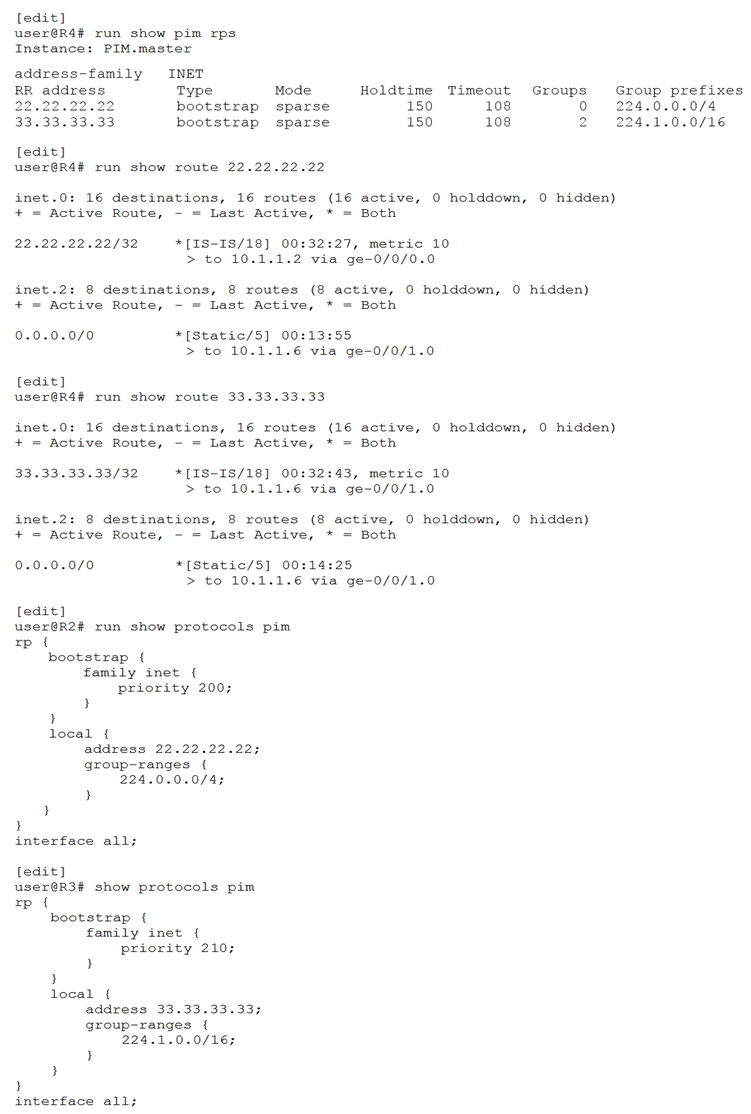
R4 is directly connected to both RPs (R2 and R3). R4 is currently sending all joins upstream to R3 but you want to load balance the joins between both RPs.
Referring to the exhibit, which configuration change will solve this issue?

R4 is directly connected to both RPs (R2 and R3). R4 is currently sending all joins upstream to R3 but you want to load balance the joins between both RPs.
Referring to the exhibit, which configuration change will solve this issue?
To load balance PIM (Protocol Independent Multicast) joins between both RPs (Rendezvous Points), you need to configure the join-load-balance parameter under PIM on R4. This configuration will distribute the PIM join messages equally among all equal-cost upstream paths to the RPs. This ensures that the multicast traffic load is balanced between the available RPs, effectively addressing the desire to load balance joins between R2 and R3.
I am alone but I think the answer is C. :) The multicast network is using a bootstrap router to announce the available RPs to the rest of PIM neighbors. The priority value shown in the exhibit is used to choose which router will act as bootstrap, but it does not indicate which one will be the RP, so option D is discarded. The definition of join-load-balance says "you can configure PIM join load balancing to spread join messages and traffic across equal-cost upstream paths (interfaces and routing devices) provided by unicast routing toward a source". I think this refers to balancing traffic from a specific source to the destination using several equal cost paths, but it does not mean that we will share the load between different RPs as the question asks, so I would discard also option A. As we are using a bootstrap router, we can check that the group to RP mapping is the following (https://www.rfc-editor.org/rfc/rfc7761.html#section-4.7.1) If we choose option C, we will have a tie in the first 2 steps and we will let the output of the hash function decide, which I think is some kind of "random" number which helps to balance the traffic to different RPs.
first part of your answer is correct. However on the second part, they won't tie on the first step, R3 wins.
agree, answer is C
R3 has a higher priority at the moment
100% not A, because the multicast section i got zero percent correct after i chose A for this question.
* PIM join load balancing: Normally, if multiple equal-cost paths toward source exist, only 1 will pass the RPF check For PIM sparse mode, load sharing can be enabled so that all equal-cost links can be used on an (S,G) by (S,G) basis
[edit protocols pim ] user@router# show join-load-balance;
The domain bootstrap router initiates bootstrap messages, which are sent hop by hop within the domain. The routers use bootstrap messages to distribute RP information dynamically and to elect a bootstrap router when necessary. By default, each routing device has a bootstrap priority of 0, which means the routing device can never be the bootstrap router. A priority of 0 disables the function for IPv4 and does not cause the routing device to send bootstrap router packets with a 0 in the priority field. The routing device with the highest priority value is elected to be the bootstrap router. https://www.juniper.net/documentation/us/en/software/junos/multicast/topics/topic-map/mcast-pim-bootstrap-router.html This means that the priority is "like the priority of OSPF election DR route" and we require the load balance configuration only
D for me, A: is incorrect - **You configure PIM join load balancing on the non-RP routers in the PIM domain.**
Exactly and R4 is a non-RP. R2 and R3 are RPs. So 'A' is correct.
Agree with A
A. Configure the join-load-balance parameter under PIM on R4. is the correct answer.
https://www.juniper.net/documentation/us/en/software/junos/multicast/topics/task/mcast-pim-join-load-balance.html
D for me, A: is incorrect - **You configure PIM join load balancing on the non-RP routers in the PIM domain.**
The correct asnwer is A. When PIM join load balancing is configured, the PIM joins are distributed equally among all equal-cost upstream interfaces and neighbors. There is also no way to administratively give preference to one neighbor over another: all equal-cost paths are treated the same way. You configure PIM join load balancing on the non-RP routers in the PIM domain. https://www.juniper.net/documentation/us/en/software/junos/multicast/topics/task/mcast-pim-join-load-balance.html